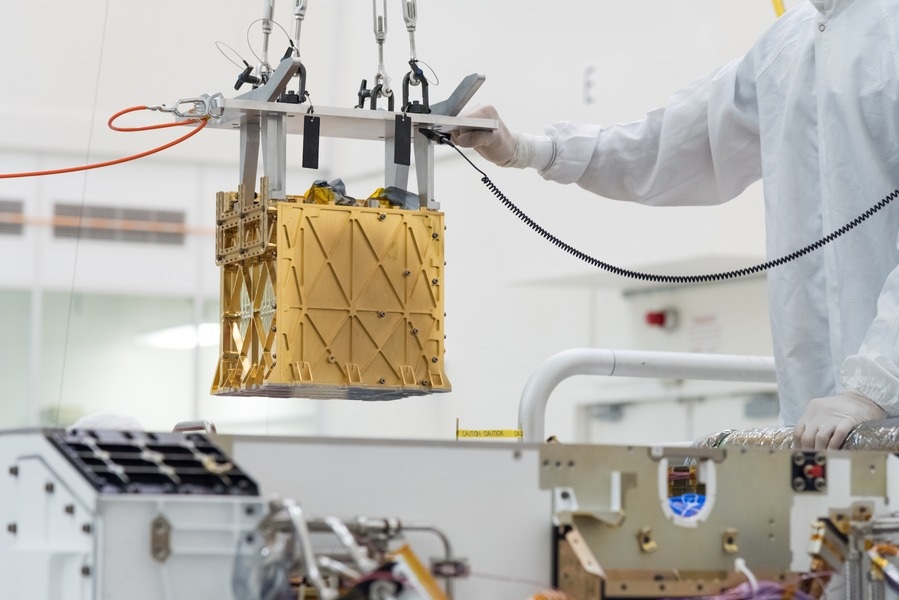Since completing the first successful flyby of Mars in July 1965, scientists have wondered what potential the red planet offers and if humanity is a step closer to being able to take its bold first steps on the surface.

Image Credit: MIT
While exploration missions have been proposed and drawn up, the engineering of interplanetary journeys is extremely complicated as questions are raised around the atmosphere and resources and how sustainable exploration of the planet could be.
Now, a study recently published in the journal Science Advances outlines the MIT-led Mars Oxygen In-Situ Resource Utilization Experiment (MOXIE), which has been generating an oxygen supply and could help answer some of the questions about how to make the most of an atmosphere abundant in carbon dioxide.
This is the first demonstration of actually using resources on the surface of another planetary body, and transforming them chemically into something that would be useful for a human mission… It’s historic in that sense.
Jeffrey Hoffman, MOXIE Deputy Principal Investigator, Department of Aeronautics and Astronautics, MIT
In-Situ Resource Utilization
MOXIE is nothing short of remarkable as a concept, given the fact that it is able to do the work of a small tree 100 million miles away from planet Earth. MOXIE is able to convert carbon dioxide on Mars into oxygen via a solid oxide electrolysis assembly.
The researchers claim that this is the first successful presentation of In-Situ Resource Realization (ISRU) on another planet after demonstrating that MOXIE was able to generate an oxygen supply in various conditions on seven separate occasions between February 2021 and December 2021. The device was able to convert carbon dioxide into oxygen at a rate of six grams per hour at different points in the year during both day- and nighttime conditions.
The idea is that ISRU could be scaled up in the future, and a larger version of MOXIE could be transported to the red planet ahead of a human-led exploration of Mars to provide a consistent oxygen supply.
Scaling up such a system to generate oxygen production at a rate of 2 to 3 kg/hour could yield sufficient oxygen to enable the launch of a manned mission that would land 26 months later.
We have learned a tremendous amount that will inform future systems at a larger scale.
Michael Hecht, Principal Investigator of the MOXIE Mission, Haystack Observatory MIT
Carbon Dioxide to Oxygen Conversion
In its current state, MOXIE is able to convert Mars’ atmosphere into pure oxygen. It achieves this by pulling the CO2-rich Martian air in through a filter that eliminates contaminants. Once the air has been pressurized, it is transported through the Solid Oxide Electrolyzer (SOXE), which was designed and assembled by OxEon Energy. The electrolyzer then splits the Martian air into oxygen ions and carbon monoxide through an electrochemical process.
To produce breathable air, the oxygen ions are first isolated and then recombined to produce molecular oxygen (O2). The oxygen is then measured for quantity and purity by MOXIE before it is released back into the atmosphere – along with other atmospheric gases, including carbon monoxide.
Due to the variable nature of Mars’ atmosphere, it was crucial that the MIT-led team was able to demonstrate a working concept at various times of the day and year.
The atmosphere of Mars is far more variable than Earth… The density of the air can vary by a factor of two through the year, and the temperature can vary by 100 degrees. One objective is to show we can run in all seasons.
Jeffrey Hoffman, MOXIE Deputy Principal Investigator, Department of Aeronautics and Astronautics, MIT
The next steps of the project are monitoring the system's operational capacity and how it withstands the fluctuating atmospheric conditions of the red planet to assess scalability options. Supported by NASA, the MIT-based team wants to run the MOXIE system at full capacity during sunrise and sunset, when temperatures tend to shift significantly.
In the future, missions to Mars may not be bogged down by oxygen-related logistics issues as a source could be ready and waiting for the first humans to arrive on the planet. Furthermore, the system could produce enough oxygen to also produce a fuel supply for astronauts, suggesting a sustainability factor in the technology.
References and Further Reading
Hoffman, J., Hecht, M., Rapp, D. and Hartvigsen, J., et al., (2022) Mars Oxygen ISRU Experiment (MOXIE)—Preparing for human Mars exploration. Science Advances, [online] 8(35). Available at: https://www.science.org/doi/10.1126/sciadv.abp8636
Chu, J., (2022) MIT’s MOXIE experiment reliably produces oxygen on Mars. [online] MIT News | Massachusetts Institute of Technology. Available at: https://news.mit.edu/2022/moxie-oxygen-mars-0831
Disclaimer: The views expressed here are those of the author expressed in their private capacity and do not necessarily represent the views of AZoM.com Limited T/A AZoNetwork the owner and operator of this website. This disclaimer forms part of the Terms and conditions of use of this website.